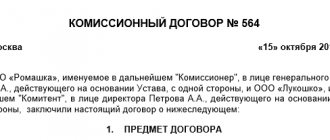What is a deferred payment to a supplier?
When we talk about deferred payment to a supplier, we mean payment of debt for products, when the entire amount is postponed to a later date than specified in the contract.
Nowadays, goods are often delivered with deferred payment to the supplier, this is a common practice for many organizations. Depending on the liquidity of the product, the supplier may provide a loan for a period of several days to several months, during which the buyer is obliged to pay for the products he purchased.
In this case, the buyer has the following benefits:
- There is no need to withdraw significant funds from circulation;
- There is virtually no risk of receiving a defective product;
- It is convenient to repay debt due to a flexible schedule.
There is also a benefit for the supplier.
The fact is that by delivering goods with deferred payment, the supplier acquires significant competitive advantages. Now he can not only attract new clients, but also build long-term, mutually beneficial relationships with them. Also from practice, you can see that a delay contributes to a significant increase in the amount of the check and, as a result, the supplier’s profit increases.
Additional agreements of the parties
Of course, the parties can change their obligations, necessarily agreeing with each other on the newly arisen conditions. Then, in order for the provision regarding new circumstances under the contract to be legal, the following can be provided.
According to the rule (Article 450 of the Civil Code of the Russian Federation), changes under the contract are possible if the parties have agreed on this in writing . In this case, a unilateral refusal of a transaction can be considered justified only in the event of a significant deviation by the other participant in the relationship from the terms of the transaction.
Based on the practice of conclusion, specific conditions for the supply of goods between legal entities are agreed upon by an additional agreement . This may be an indication of the name, type, batch of goods, its quantity, GOST or TU, delivery time, deferment period, possible interest or bank account details for debt repayment.
How to calculate how much a deferred payment to a supplier will cost a client
It must be remembered that every time a supplier defers payment, he incurs financial losses. Most organizational leaders calculate the cost of deferment as follows:
To calculate your savings, you will need this formula:
OP = (KDO / 365) x (BP / 100%) x SK,
Values: OP – deferment amount, rub.;
KDO – number of days of deferment;
BP – bank percentage on borrowed funds, %;
SC – contract amount, rub.
The calculation using the above formula shows quite accurately how much money you will save if you take advantage of deferred payment from the supplier. The essence of it is that you calculate what funds you would spend to take out a bank loan and pay directly upon delivery.
In addition, this formula will show how much money your organization spends by giving respite to its customers. To obtain this indicator, add 20% to the resulting number, which takes into account the risks of complete non-repayment of funds and expenses to collect overdue debt.
To estimate the cost of credit funds, take into account both the annual interest and all sorts of one-time bank payments for opening a line of credit: all kinds of commissions, registration and insurance of collateral and other expenses that arise when applying for and servicing a loan.
There are entrepreneurs who, with this formula for calculating the deferment for a supplier, consider not the bank’s percentage, but the profitability of alternative financial investments (for example, in shares, in another business), or a certain percentage that is tied to the profitability of the business.
This formula will be useful to you if you want to purchase products with prepayment, and also with long delivery. Here it turns out that you are essentially lending money to the supplier. Prepayment is calculated in the same way, only replace the number of days of deferred payment to the supplier with the number of days from payment until the goods arrive to you.
There is such a practice: in a company, the client pays a price, and a percentage is added to it, depending on how many days the payment to the supplier will be deferred. For example, a product costs 200 rubles, if postponed for a week – 202 rubles, and for a month – 210 rubles. Here, first of all, prices that are offered with a deferment must be improved as much as possible, and it is also necessary to calculate the benefits of this proposal.
You can evaluate the profitability of the cost of a product with a deferment in comparison with the cost without it using the following inequality:
NZO / (100% - NZO) x (365 / KDO) x 100% ≤ BP,
where NPO is the premium for deferment, % (how much discount is lost if the transaction takes place using a deferred payment to the supplier);
KDO – number of days of deferment;
BP – bank interest on a loan, %.
When the inequality is satisfied, then using the supplier’s funds is more profitable than a loan, and deferring payment to the supplier will be profitable. In the same case, if the inequality is incorrect, that is, the number on the left side is greater than on the right, then it is not profitable to defer.
Let's say you purchase canisters and pay for them upon delivery. The cost of one canister is 200 rubles. As a result of negotiations on improving delivery conditions, you came to the conclusion that, taking into account the 21-day delay you are interested in, the price of a canister for you will be 206 rubles. The financial director announced that your company can now borrow funds at 22% per annum. So, your premium for deferred payment to the supplier will be (206 ‒ 200) = 6 rubles, which is 3%. Now you need to evaluate the profitability of deferment under these conditions:
3 / (100 — 3) × (365 / 21) × 100% = 53,75 ? 22
53,75% > 22%
The number on the left is significantly larger than the one on the right. Inequality showed that under the given working conditions, it is simply unprofitable to defer. It is necessary to either negotiate again, or make a strategically important decision: you agree to work with payment upon delivery, or you prefer deferred payment to the supplier, which will be much more expensive than credit money. In this example with canisters, it will be beneficial for the entrepreneur to negotiate a deferment of 21 days with a price increase of a maximum of 1.25%.
Read the material on the topic: How to save on payroll taxes so that everyone is happy
Most foreign manufacturing companies do not agree to deferment terms with Russian suppliers. They strive to get the lowest price and convenient conditions instead. At the same time, the European currency is worth six to ten times less than the Russian currency at a loan rate of about 3% per annum. This is why it is unprofitable for an organization from Europe to negotiate a deferred payment with suppliers from Russia; this amounts to expensive lending.
When there is a need to compare two suppliers with an identical product, but with different prices and a deferred payment to the supplier (when other conditions are equal), you can use the “conditional purchase price” - estimate the cost of the purchase taking into account the deferment using this formula:
UslZak = ZAK x (1 – (BP / 100%) x (KDO / 365)),
where UslZak – conditional purchase price with deferment, rub.;
ZAK – purchase cost, rub.;
BP – percentage of borrowed funds from the bank;
KDO – number of days of deferment.
For example, supplier 1 provides a product worth 200 rubles. without deferred payment. Supplier 2 can offer a price of 205 rubles. and a 30-day grace period. Let's say that your organization can borrow funds at 22% per annum. Which of the two offers is more profitable? We calculate the conditional purchase price in these two cases:
Fast. 1: UslZak = 200 × (1 – (22 / 100) × (0 / 365)) = 200 rub.
Fast. 2: UslZak = 205 × (1 – (22 / 100) × (30 / 365)) = 201.3 rub.
So, in the first case there is no deferred payment to the supplier, but this particular offer is more profitable than that of the second supplier. This formula makes it possible to calculate that the offer of the second supplier is more profitable than the offer of the first if the delay is more than 41 days.
Minimum and maximum terms
As for the legislative norms that could determine the minimum period for deferred payment, it should be noted that the Civil Code does not limit .
At the same time, it would be natural to assume that the parties in this case are guided by their capabilities both in providing a deferment and in terms of payment obligations.
The seller, by providing the goods, determines the effectiveness of the commercial contract, the optimal policy for providing a payment deadline, which could stimulate the growth of its sales. The buyer, in turn, is also guided by his financial capabilities, which undoubtedly affects the results of his business activities.
How to draw up an agreement under which a deferred payment is granted to a supplier
Before you begin drawing up an agreement that provides for deferred payment to a supplier, familiarize yourself with important aspects of the law in advance. This way you will avoid a lot of difficulties later. Carefully study issues related to the legal validity of the contract so that there is no situation where it is impossible to use it in court.
It is worth studying these sections of the Civil Code:
- Art. No. 485 of the Civil Code of the Russian Federation - How to determine the pricing policy of products, etc.;
- Art. No. 486 of the Civil Code of the Russian Federation - Payment for products, regulations;
- Art. No. 487 of the Civil Code of the Russian Federation - How goods are pre-paid;
- Art. No. 488 of the Civil Code of the Russian Federation - How to implement payment for products sold on credit;
- Art. No. 489 of the Civil Code of the Russian Federation - Issues relating to payment for goods in installments;
- Art. No. 490 of the Civil Code of the Russian Federation - Issues related to product insurance;
- Art. No. 491 of the Civil Code of the Russian Federation - On the seller’s property rights until payment.
Remember that the most basic points must be reflected in appropriate documents. Based on them, the form of the future agreement is selected, where the relations of the parties will be formalized, confirmed by documents.
As a rule, deferred payment to the supplier is initially included in the contract for the supply of goods. For this reason, the main document you will rely on is the Civil Code of the Russian Federation.
It would be optimal to formulate an appropriate agreement that includes a deferred payment to the supplier. Currently, it is quite easy to find a template that will be drawn up taking into account all regulatory documents.
This kind of document is compiled according to a strictly defined format, including the following sections:
- The name of the document and its individual serial number;
- Where was the contract drawn up and when?
- Supplier – a specific official, full name and position;
- Customer – also full name, position;
- Subject of the agreement;
- Rights and obligations of the parties; delivery conditions;
- Cost of products, terms of payment for them; how controversial situations are resolved; conditions for changing and terminating the contract after conclusion;
- Obligations of the parties;
- Procedure in case of force majeure;
- The duration of the contract and what determines it;
- Conclusion; legal addresses of the supplier and customer.
It is important to know that the maximum amount of deferred payment to the supplier varies in different ranges - from 0 to 100%. The amount of deferment depends on the product itself and the method of its sale. There are many different nuances that are associated with deferment. As a rule, a deferred payment to the supplier is needed when products are purchased for sale, then debts are settled after their sale. Chain stores often operate using this system. The goods are purchased from the supplier, after which they are sold within a certain period of time, and only then payment for the products is made.
Read material on the topic: Types of tax audits and their features
Other conditions
8.1. This agreement comes into force from the moment it is signed by the Parties and is valid until [date. month year].
8.2. The Agreement is terminated early in cases provided for by the current legislation of the Russian Federation.
8.3. Upon termination of this agreement, the Parties are not released from their unfulfilled obligations, payment of interest due and compensation for losses arising from non-fulfillment or improper fulfillment of their obligations under this agreement.
8.4. Changes and additions to the agreement are made in writing and signed by the Parties.
8.5. Disputes and disagreements arising from this agreement or in connection with it, the Parties will strive to resolve through negotiations.
8.6. If the Parties to this agreement do not come to an agreement, disputes and disagreements are subject to consideration by the Arbitration Court in accordance with the current legislation of the Russian Federation.
8.7. This agreement has been drawn up in two copies, one for each of the Parties, having equal legal force.
8.8. On issues not reflected in the agreement, the Parties are guided by current legislation.
Trade Law and Deferred Payment to Food Suppliers
It is important to know about current changes in the Trade Law, which affected issues with deferred payment to suppliers for food products.
Due to recent amendments, all aspects of the contract for the supply of food products are established by their expiration date. In the event that this period does not exceed 10 days, the deferment period is assigned no more than 10 working days from the date of acceptance of the goods by the buyer. If the storage period is from 10 to 30 days, then the deferment of payment to the supplier is a maximum of 30 days (according to the calendar) from the date of receipt of the goods. When the product is good for more than 30 days, the buyer must pay for such products no later than 45 calendar days from the date of receipt.
Quality, assortment, quantity, packaging of the supplied goods
2.1. The Supplier transfers to the Buyer the Goods in the quantity and assortment specified in the Addendum to this contract for each separately delivered batch.
2.2. The Supplier transfers to the Buyer the Goods that comply with the quality certificate provided by the Supplier for each type of product, with a specified expiration date.
2.3. The Supplier transfers the Goods to the Buyer in packaging that ensures its safety during transportation, as well as from exposure to atmospheric conditions.
2.4. The Buyer undertakes to notify the Supplier of any violation of the terms of this agreement, the quantity and quality of packaging upon acceptance of the goods.
2.5. In case of failure to comply with the rule provided for in clause 2.4 of this agreement, the Supplier has the right to refuse, in whole or in part, to satisfy the Buyer’s demands for the transfer of the missing quantity of the Goods, the replacement of quality or assortment that does not meet the terms of the contract, the elimination of defects in the Goods, the replenishment of goods, or the replacement of incomplete Goods with a complete one. , about the packaging of the Product.
How to convince a supplier to defer payment if he refuses
Alas, entrepreneurs often refuse a deferment, having compelling reasons for this, because by supplying products with a deferred payment, the supplier risks:
- Cash gaps;
- Desynchronization of commodity and financial flows;
- Reducing the volume of funds in circulation;
- Reducing available liquidity;
- Reduced profitability and financial stability of the company.
In addition to the above, the situation may be aggravated by the fact that monitoring accounts receivable is traditionally the responsibility of a sales manager (one or more), and this is not very correct. After all, the sales manager strives to increase sales, and he is a person interested in maintaining good relationships with the buyer. And the manager, as a rule, when there is a delay in deferred payment payments to the supplier, finds it difficult to find leverage when the debtor simply does not fulfill its obligations.
However, there is no need to despair. Such a thing as granting a deferred payment to a supplier in the domestic market is a common thing. In addition, if previously loans were given only for consumer goods, today this practice is ubiquitous. This is beneficial for both parties. The supplier gets loyal customers, while the buyer now has the opportunity to pay not immediately, but, for example, 2-3 months later. There are, of course, accompanying difficulties, but they are all solvable.
A very convenient solution to this issue is the appearance of a third party: it can “close” the cash gap and take on the risk of non-payment. This third party may be a factoring organization that provides a range of services, including those related to financing supplies, guaranteeing receipt of payments, or simply purchasing receivables. The listed services are accompanied by debt management for deferred payments to the supplier. Such companies accompany payment for supplies from the moment of monitoring the duration of the payment period until the full range of actions for the return of receivables.
The whole range of the above, it essentially provides factoring here, and whether the funds will be returned to the factoring company depends on this. At the same time, the supplier receives both financing and guarantees - he is provided with funds at the time of deferred payment, for him such cooperation simply eliminates losses.
Cooperating on factoring is not only about building relationships so that the procedure for deferring payment to the supplier is beneficial to both parties. Therefore, before entering into this cooperation, both the client and the factoring company must voice their own capabilities and expectations. For example, a client has 5 debtors who receive products monthly on deferred payment to suppliers for a total amount of 30 million rubles. The client can transfer such debtors to factoring in order to receive funds at the time of deferment, thereby filling the emerging cash gap. An independent factoring company has the ability to finance receivable deliveries and accept the risk of possible non-payment for products.
Read the material on the topic: How to open a current account for an individual entrepreneur without problems and sleep peacefully
The process of factoring services begins from the moment the initial deliveries are transferred, before which an agreement is signed between the company and the factor. With the conclusion of the contract, the client begins to transfer information about debtors in order to set a limit on them and subsequent services. But before setting a limit on a debtor, the factoring organization first of all collects information on all transferred debtors, and then sets limits. The amount of the limit can be considered in fact the size of the risks that the factoring organization bears by paying the client funds for shipments to this buyer, issuing a guarantee in the event of probable non-payment of deferred payments to suppliers and assuming obligations, if necessary, to compensate for losses or to buy out receivables from the client.
At the same time, the matter is not limited only. It is also important that the debtor signs an agreement regarding factoring. He accepts the terms of the notification about the transfer of payments to the factoring organization and agrees to take action on receivables, and if there are delays, they will call and promptly remind about payment.
So, there is a signed agreement on deferred payment to the supplier, verified debtors, established limits, as well as all signed notifications. From this point on, the supplier can ship the product on a deferred basis, and he can be sure that he will receive financing upon shipment of the product and the transfer of information about the shipment to the factoring organization.
This is what the essence of the whole picture looks like, without descriptions of its various nuances. In this case, we can consider, in general, all the functions of factoring:
- Checking the buyer’s credit history and business reputation;
- Control over payment for delivery;
- Assumes the risk of non-payment;
- Helps in building a competent tariff and limit policy for the organization.
Naturally, deferring payment to a supplier is much more complicated and has numerous nuances, which should only be taken into account by a specialist with extensive experience. Finding one is a real headache, but you are reading this article, which means that such a problem will not arise for you: specialists who provide accounting services to small and medium-sized businesses have extensive experience and will be able to help you understand what is related to the issues on deferred payment to the supplier, and more. Working with Business Resource, you will be protected from all kinds of risks and will receive a responsible contractor who will provide the advice you need and quickly carry out all the necessary professional procedures.
Procedure, terms and conditions of delivery
3.1. Delivery of products is carried out within the period specified in the Addendum to this contract for each separately supplied batch.
3.2. In case of underdelivery, the quantity of underdelivered products is subject to additional delivery with the next batch.
3.3. Delivery of products to the Buyer is carried out by the Supplier [type of transport, transportation conditions].
3.4. When shipping the Goods to the Buyer, these Goods must be inspected by the Buyer or an authorized representative of the Buyer at the place of shipment, including the Buyer must check the compliance of the Goods with the terms of this agreement, the information specified in the delivery note for these Goods, as well as the quantity, quality, assortment and packaging of Goods. If defects are detected during the shipment of the Goods, inconsistencies with the terms of this agreement and the information specified in the invoice for these Goods, the Buyer notifies the Supplier of this, drawing up a written Certificate of Return of the Goods when returning part of the Goods to the Supplier.
3.5. The Supplier is considered to have fulfilled the obligation to supply the Goods if it has been delivered to the place and time specified by the Buyer, and also, as a result of acceptance by the Buyer, the quantity, quality, assortment and packaging of the goods specified in the additional agreement have been established.
How else to increase the deferred payment from the supplier
There are 2 options to convince to defer payment:
- Insist that the supplier enter into the organization's position;
- Inform about agreements with other sellers.
Negotiations conducted with a supplier using the “Enter our position” strategy are essentially bargaining. You should resort to a bargaining strategy when the seller is a monopolist, and you are completely satisfied with the quality and delivery times. When meeting with the counterparty, explain why you need a deferred payment from the supplier and for how long.
When you are preparing for negotiations, ask the merchants for a forecast of their income for the next 3 months. Find out from them whether they will fulfill their share of shipping obligations within such a period. It is important to study all reports on debts and assess how much they have increased and what measures have been taken to return the overdue ones.
The collected information data will give you the basis for preparing arguments to the counterparty; you must explain why there was a cash gap, and also convince that the organization’s problems are temporary.
Prove in numbers how many days you need to extend the deferred payment to the supplier and why, a financial forecast for the next 3 months will help you with this. Prepare two versions of it. In one, focus on the current deferred payment from the supplier, in the second, indicate the data that will allow you to avoid a financial deficit. There is no need to list every item of income and payment; indicate only the largest ones.
When you ask a supplier to defer payment, be prepared to offer something in return. Think about the options in advance and consider whether they are interesting to the seller and whether they are beneficial to the organization. Collect data about the counterparty from open sources, study the situation on the market. When there is a drop in demand for a supplier’s product, offer him:
- Provide advertising to your clients, as a result of which the supplier will have new customers;
- Expand the selection of the entire assortment. This option needs to be discussed with merchants;
- Take mutual participation in promotions;
- Sign a contract for a long period.
When demand for a supplier's product is good, you can offer:
- Increase the purchase price within the deadline for increasing the deferred payment to the supplier. To understand how acceptable this is, prepare a financial flow forecast. In this forecast, indicate the delay you need and include an increase in the purchase price;
- Increase the volume and frequency of purchases. Use this method when the company plans to expand its own business or open new stores. Estimate what order volume will be optimal for you, or whether the cash gap will increase even more;
- Eliminate debts for paying for products.
If there is a need to notify suppliers of agreements with other sellers so that a deferred payment to the supplier can be granted, you can proceed as follows.
Suppose the organization sells a non-unique product, the supplier is not a monopolist - during negotiations, resort to talking about working with other suppliers. At its core, this method is blackmailing the supplier.
Before you begin negotiations to extend the deferment of payment from a supplier, you need to collect information about key suppliers with whom you do not have any contracts. Visit the websites of these companies, study price lists, and request commercial offers.
Check with these suppliers all the conditions - how the goods are paid for, how the goods are delivered, what discounts are possible (for example, volumetric and related to the frequency of purchases).
To form a portfolio of different sellers, display all received data in a table. Thanks to it, you can quickly switch to alternative suppliers if negotiations with the current one do not bring the result you need.
If you are refused a deferred payment for the supply of goods, say that your organization has other lucrative offers and you are ready to part ways. It is likely that this argument will cause this supplier to change his mind.
Read the material on the topic: How to switch to the simplified tax system
Responsibility of the Parties
7.1. For an unreasonable refusal to accept goods or for delay in sampling the goods, the Buyer shall pay the Supplier a fine in the amount of [value]% ([enter as appropriate]) of the cost of the shipped Goods.
7.2. In case of late payment, the Buyer is obliged to pay the Supplier a penalty in the amount of [value]% ([enter as required]) of the cost of the Goods for each day of late payment.
7.3. If payment for received products is overdue for more than [value] ([enter as required]) days, the Supplier stops accepting orders from the Buyer and suspends the fulfillment of its obligations under this agreement until the Buyer repays the debt.
7.4. In case of delay in delivery of goods, the Supplier is obliged to pay the Buyer a fine in the amount of [value]% ([enter as appropriate]) of the cost of the undelivered Goods.
The Buyer is not responsible for refusing to accept Goods whose delivery is overdue by [value] ([enter as appropriate]) days.
7.5. The parties are not liable under this agreement if the violation of the terms is associated with force majeure circumstances (natural disasters, military actions of government agencies, etc.), the presence of which must be confirmed by [fill in as appropriate].
How to write a letter to a supplier about increasing the deferred payment
Often, managers are forced to draw up a letter themselves to extend the deferred payment to the supplier. In these cases, you may find the following guide useful.
Step 1. Looking for ready-made forms
You need to check with your bank whether they have ready-made templates for letters with a reasoned request to change loan terms. If your bank already has ready-made forms, just take one and fill it out. You will need to enter the loan agreement number and full name, as well as indicate the name of the bank in the header of the document. After this, select an option or a couple of options for argumentation: a deferred payment to the supplier of credit funds may be assigned due to layoffs or layoffs, or a deterioration in the financial situation, or a decrease in income.
Step 2. Write the letter yourself
If your bank does not have such forms, write a letter yourself. It is drawn up for the chairman of the bank. In the header of the document you must write: “to: Chairman of the Board of the Bank.” After this, enter the name of the bank and the full name of the chairman. Then go to step 3.
Step 3. Add the necessary information
Then check who the letter is from. Like this: “from whom: Marina Alexandrovna Petrova.” These types of letters are usually written in free form. You can write something like this: “I, Marina Aleksandrovna Petrova, am a client of your bank... (here note how long you have been a client of this bank). Based on the loan agreement number ... I ask you, (full name of the chairman), to grant me a deferred payment for (the desired duration of the deferment). Due to the fact that...” Here write the reason why you need a deferred payment to the supplier, i.e. why you are unable to repay the loan on time. Then proceed to the next step.
Step 4. Information is verified
In the letter about deferred payment to the supplier, you must provide real information. Write what really is. For example, if you need to change your credit terms due to delays in salary payments or lack of a permanent job, write so. After that, go to step 5.
Step 5. Signature and other necessary formalities
Sign and decipher the signature, as well as today's date. Then comes the next step of the recommendation.
Step 6. Sending an email
Now the letter is ready! Take the document to the bank and be sure to have it endorsed by the secretary or administrator. And it’s better to send a letter with notification - then you will know for sure that the addressee has received the letter.
Cost and payment procedure
4.1. The Goods supplied under this agreement are paid for at the prices determined by the Parties in the Additional Agreements, which are an integral part of this agreement.
4.2. Product packaging is included in the price of the supplied products.
4.3. Payment for each delivered shipment is made by the Buyer within [specify period] from the date of delivery of the Goods to the Buyer.
4.4. Payment is made based on invoices issued by the Supplier.
4.5. Payment for the Goods is made by non-cash payment orders to the Supplier's bank account.
4.6. The date of payment is considered to be the date [the date the Buyer’s bank accepts payment documents for execution and the receipt of funds to the Supplier’s current account].
Subject of the agreement
1.1. The Supplier undertakes to deliver the Goods into the Buyer’s ownership within the period stipulated by the contract for use in business activities or for other purposes not related to personal, family, home and other similar use, with a deferred payment established by this contract.
1.2. The Buyer undertakes to accept and pay for the Goods in the manner prescribed by the contract.
1.3. The goods under this contract are [fill in as appropriate].
1.4. The Supplier undertakes to supply the specified Goods with the relevant documentation.






